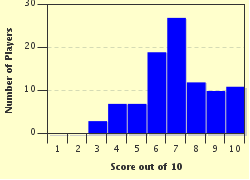Quiz Answer Key and Fun Facts
1. In the year 14 A.D., Augustus, the first emperor of Rome, died. Who was his successor?
2. In China, Wang Mang established the so-called Xin Dynasty, albeit for a relatively brief period, after having overthrown which other dynasty?
3. The Battle of the Teutoburg Forest was a major military defeat the Romans suffered when trying to expand into Germanic lands. Who led the Germanic forces against the Romans?
4. Between the years 30 to 33 A.D., Jesus was arrested and put to death. What was the method of his execution?
5. Between 40 to 43 A.D., a pair of sisters would lead an uprising against the Han Dynasty in an attempt to remove them from their homelands. Where did this rebellion take place?
6. Around 60 A.D. there was a major revolt against Roman rule in Britannia that led to the deaths of tens of thousands. Who was the leader of this revolt?
7. In 64 A.D. a massive fire broke out in the city of Rome. Who was the emperor at the time?
8. During the 1st century, a nomadic group would end up establishing a large empire that stretched from Afghanistan to Northern India. Who were these nomads?
9. Between 66 to 73 A.D. there was a large rebellion that took place against the Roman Empire in the Middle East that ended with the Siege of Masada. What religion did the rebels follow?
10. In 79 A.D. a massive volcanic eruption destroyed the cities of Pompeii and Herculaneum. What was the name of the volcano that erupted?
Source: Author
Avalice
This quiz was reviewed by FunTrivia editor
bloomsby before going online.
Any errors found in FunTrivia content are routinely corrected through our feedback system.

